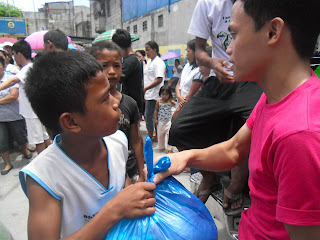Friday, August 31, 2012
Saturday, August 25, 2012
Thursday, August 23, 2012
Wednesday, August 22, 2012
Flooding in the Metro, not the poor people’s fault – Samahang Operasyong Sagip
This was Samahang Operasyong Sagip’s (SOS) reaction on the
“typical victim-blaming” attitude of the government on the massive flooding
caused by the southwest monsoon that badly hit Luzon and affected 89,114 families, left behind 92 people dead,
destroyed thousands of homes and damaged P616 million worth of crops and
infrastructure.
Christ Ian Mostrales, a registered nurse and coordinator of
SOS said that Mr. Aquino should deeply look into the reasons why millions of
Filipinos remain vulnerable to the effects of disasters year in and year out. He stressed that “political and economic
disenfranchisement further push the majority poor” into situations and places
that put their lives and limbs at risk.
Instead of blaming the poor for the flood, Mostrales said
that Mr. Aquino should review his previous decision on the cancellation of 19
projects under the “Post Ondoy and Pepeng Short-Term Infrastructure
Rehabilitation Project” a few months after he assumed office in 2010. The project sought to repair damaged flood
control facilities in Luzon that were ravaged by the two typhoons. In the absence of a better blueprint for
flood solution, Mostrales said that the administration even cancelled the P18.7
billion Laguna Lake dredging project which aimed to permanently solve the
flooding in Laguna and adjacent provinces and cities. Earlier this year, around 79 percent of the P7.5 billion Quick Reaction Calamity Fund
was already spent – leaving only P1.6 billion for the typhoons that are
expected to hit the Philippines this year. Government allotment for disaster preparedness,
mitigation, and rehabilitation has had a very meager share in the national budget allocation.
In exchange for these long-term solutions, the Aquino
government resorted to stop gap solutions like the clearing of waterways and
drainage systems of all makeshift structures that block them – with DPWH
Secretary Rogelio Singson saying “even going to the extent of blowing up
structures that block waterways to ease flooding”.
Mostrales reiterated
that the statement is insensitive especially considering that most families whose
houses have been demolished in Damayang Lagi, Quezon City and Isla Puting Bato
in Tondo Manila experienced a double whammy when their new homes were ravaged
by floods. The “illegal structures” of
urban poor families are not the main problem why there is flooding and
demolishing these structures will not solve the problem of flooding and
congestion.
“Who would want to live in dirty esteros, landslide-prone areas, river side, break waters, or
shorelines if these people were properly employed, earning a livable wage, or
were not displaced from their lands in the countryside because of large scale
mining and land-grabbing?”
“The Philippines experience an average of twenty tropical
cyclones per year. Hence, the government
should focus more in long-term structural enhancements and more importantly,
capacitate the people by providing adequate social services and equal economic and
political opportunities to mitigate the adverse effects of disasters,”
Mostrales ended.
SOS is a network of organizations, volunteer health workers,
professionals and students that aim to render assistance to disaster victims
through various responses such as disaster preparedness and mitigation
initiatives, relief and medical missions and post disaster rehabilitation
efforts. It was formed in the early 1990s
in response to the big earthquake and lahar flows of Mt. Pinatubo. ##
Reference:
Christ
Ian Mostrales – 0923-1016178 / (+632) 929-8109
Spokesperson/Coordinator, SOS
Related articles
Tuesday, August 21, 2012
Relief delivery at Nagpayong, Brgy. Pinagbuhatan, Pasig City (August 21, 2012)
Volunteer student nurse from Universidad de Manila (above) and Community Health Worker (below) assist in the goods distribution
Express lane for pregnant and elderly beneficiaries
Saturday, August 18, 2012
Friday, August 17, 2012
Thursday, August 16, 2012
Wednesday, August 15, 2012
DNCA in Kasiglahan Village, Montalban, Rizal (August 15, 2012)
Ironically named "Kasiglahan" Village, which in Filipino literally means active or full of energy, thousands of people living in this community could not find the energy to pick up where they left off.
Most of the families living in Kasiglahan Village, Montalban, Rizal are relocatees from Malabon, Navotas, Isla Puting Bato in Tondo, NIA Road, and Damayang Lagi in Quezon City. They are families whose homes were demolished by the city government to make way for so-called "development projects" or were living in city-identified "danger zones."
What appeared to be the answer for their lifelong clamor for public housing turned out to be another disaster. Relocatees from Isla Puting Bato tearfully shared that "matapos nilang sunugin ang bahay namin sa Isla, basta na lang nila kami pinabayaan dito," (after burning down our homes in Isla, they [government] abandoned us here.)
Hundreds of homes burned to ashes in Isla Puting Bato in May this year. Hundreds still remain in an evacuation center in Del Pan, Manila while those who opted for relocation in Montalban suffered another tragedy.
SOS volunteers who conducted the Disaster Needs and Capacities Assessment (DNCA) on August 15 reported that some one thousand families (1,000) were directly affected by the flood.
Due to lack of a comprehensive housing plan and disaster preparedness, the lives of thousands of families in Kasiglahan Village have become more at risk than ever.
(Pictures courtesy of SOS DNCA volunteers)
Like a ghost town
Homes were ravaged by the flood from nearby Wawa Dam
Makeshift doors, which were recently placed by relocatees from Isla Puting Bato became as useless as the mud that covered the community
At the height of the southwest monsoon's fury, these houses were submerged to the roof and families were stranded in their rooftops for days without food or water
SOS volunteers conducted DNCA
Volunteers said that the houses were literally built beside the raging Wawa river
Subscribe to:
Posts (Atom)

















































.JPG)
.JPG)
.JPG)
.JPG)
.JPG)
.JPG)


